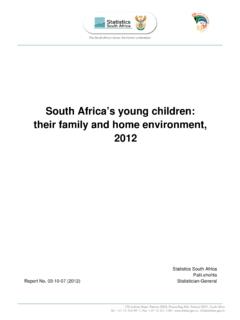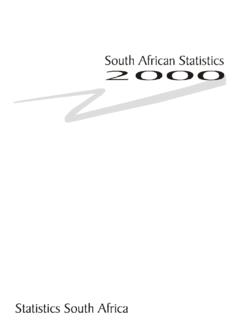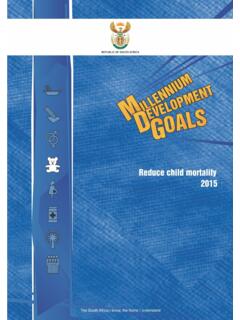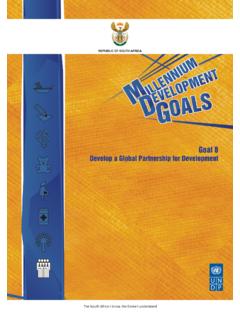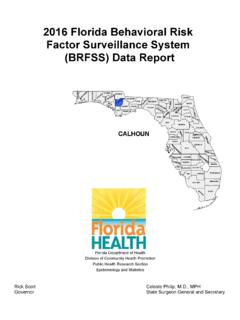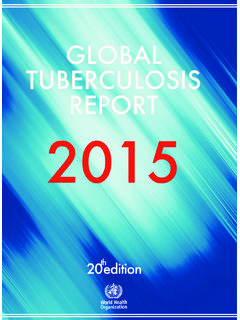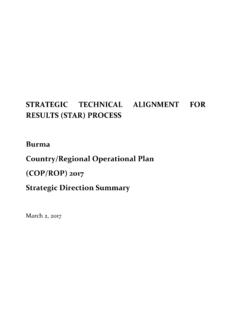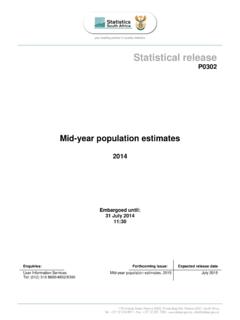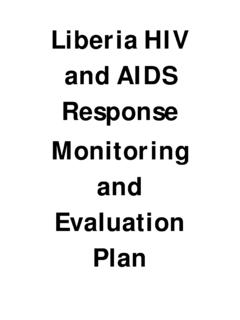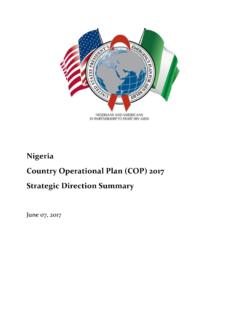Transcription of Mid-year population estimates - Statistics South Africa
1 Statistical release P0302 Mid-year population estimates2016 Embargoed until:25 August 2016 13:00 Enquiries: Forthcoming issue: Expected release date User Information Services Mid-year population estimates , 2017 July 2017 Tel: 012 310 8600/4892/8390 Statistics South Africa P0302 Mid-year population estimates , 2015 ii Contents Summary .. 1 1. Introduction .. 3 2. Demographic and other assumptions .. 3 3. Demographic and other indicators .. 5 4. National population 7 5. Provincial population estimates .. 10 Demographic assumptions .. 10 Provincial distributions .. 12 Migration patterns .. 12 Provincial estimates by age and sex .. 12 References .. 17 Tables Table 1: Mid-year population estimates for South Africa by population group and sex, 2016 .
2 2 Table 2: Mid-year population estimates by province, 2016 .. 2 Table 3: Assumptions of expectation of life at birth without AIDS and fertility .. 4 Table 4: International migration assumptions for the period 1985 2016 .. 4 Table 5: Demographic indicators, 2002 2016 .. 5 Table 6: Births and deaths for the period 2002 2016 .. 6 Table 7: HIV prevalence estimates and the number of people living with HIV, 2002 7 Table 8: Mid-year estimates by population group and sex, 2016 .. 7 Table 9: Estimated annual population growth rates, 2002 2016 .. 8 Table 10: Mid-year population estimates by population group, age and sex, 2016 .. 9 Table 11: Percentage distribution of the projected provincial share of the total population , 2002 2016 .. 12 Table 12: Estimated provincial migration streams, 2001 2006 .. 13 Table 13: Estimated provincial migration streams, 2006 2011.
3 13 Table 14: Estimated provincial migration streams, 2011 2016 .. 14 Table 15: Provincial population estimates by age and sex, 2016 .. 15 Figures Figure 1: Provincial average total fertility rate .. 10 Figure 2: Provincial average life expectancy at birth (males) .. 11 Figure 3: Provincial average life expectancy at birth (females) .. 11 Statistics South Africa P0302 Mid-year population estimates , 2015 1 Summary This release uses the cohort-component methodology to estimate the 2016 Mid-year population of South Africa . The estimates cover all the residents of South Africa at the 2016 Mid-year , and are based on the latest available information. estimates may change as new data become available. For 2016 , Statistics South Africa (Stats SA) estimates the Mid-year population as 55,91 million. Approximately fifty-one per cent (approximately 28,53 million) of the population is female.
4 Gauteng comprises the largest share of the South African population . Approximately 13,5 million people (24%) live in this province. KwaZulu-Natal is the province with the second largest population , with 11,1 million people (19,9%) living in this province. With a population of approximately 1,19 million people (2,1%), Northern Cape remains the province with the smallest share of the South African population . About 30,1% of the population is aged younger than 15 years and approximately 8,0% (4,47 million) is 60 years or older. Of those younger than 15 years, approximately 23,0% (3,86 million) live in KwaZulu-Natal and 20,4% (3,43 million) live in Gauteng. Of those elderly aged 60 years and older, the highest percentage 26,1% (1,17 million) reside in Gauteng. The proportion of elderly persons aged 60 and older is increasing over time.
5 Migration is an important demographic process in shaping the age structure and distribution of the provincial population . For the period 2011 2016 it is estimated that approximately 247 437 people will migrate from the Eastern Cape; Limpopo is estimated to experience an out-migration of nearly 305 030 people. During the same period, Gauteng and Western Cape are estimated to experience an inflow of migrants of approximately 1 216 258 and 363 114 respectively (see migration stream tables for net migration). Life expectancy at birth for 2016 is estimated at 59,7 years for males and 65,1 years for females. The infant mortality rate for 2016 is estimated at 33,7 per 1 000 live births. The estimated overall HIV prevalence rate is approximately 12,7% of the total South African population .
6 The total number of people living with HIV is estimated at approximately 7,03 million in 2016 . For adults aged 15 49 years, an estimated 18,9% of the population is HIV positive. This publication and its subsidiary products is based on the 2014 geographic boundaries and not those used subsequent to the Local Government Election held on 3 August, 2016 , since these occurred after the reference period of 30 June, 2016 . The 2017 Mid-year estimates will apply the new geographic boundaries. Statistics South Africa P0302 Mid-year population estimates , 2015 2 Table 1: Mid-year population estimates for South Africa by population group and sex, 2016 population group Male Female Total Number % distribution of males Number % distribution of females Number % distribution of total African 22 119 200 22 990 700 45 109 900 Coloured 2 368 000 2 529 200 4 897 200 Indian/Asian 701 900 684 100 1 386 000 White 2 190 700 2 325 100 4 515 800 Total 27 379 800 100,0 28 529 100 100,0 55 908 900 100,0 Table 2.
7 Mid-year population estimates by province, 2016 population estimate % of total population Eastern Cape 7 061 700 Free State 2 861 600 Gauteng 13 498 200 KwaZulu-Natal 11 079 700 Limpopo 5 803 900 Mpumalanga 4 328 300 Northern Cape 1 191 700 North West 3 790 600 Western Cape 6 293 200 Total 55 908 900 100,0 PJ Lehohla Statistician-General Statistics South Africa P0302 Mid-year population estimates , 2015 3 1. Introduction In a projection, the size and composition of the future population of an entity such as South Africa is estimated. The Mid-year population estimates produced by Statistics South Africa (Stats SA) use the cohort-component method. In the cohort-component method, a base population is estimated that is consistent with known demographic characteristics of the country.
8 The cohort base population is projected into the future according to the projected components of change. Agreed levels of fertility, mortality and migration are used as input to the cohort-component method. For the 2016 Mid-year estimates , the cohort-component method is used within the Spectrum Policy Modelling system. Spectrum is a Windows-based system of integrated policy models. The DemProj module within Spectrum is used to make the demographic projection, while the AIDS Impact Model (AIM) is used to incorporate the impacts of HIV and AIDS on fertility and mortality. Stats SA subscribes to the specifications of the Special Data Dissemination Standards (SDDS) of the International Monetary Fund (IMF) and publishes the Mid-year population estimates for the country annually. This release uses the latest available Spectrum Software from Avenir Health.
9 Stats SA used JMP Script Language (JSL) developed by the SAS Institute Inc. to do estimates lower than country level. 2. Demographic and other assumptions A cohort-component projection requires a base population distributed by age and sex. Levels of mortality, fertility and migration are estimated for the base year and projected for future years. The cohort base population is projected into the future according to the projected components of population change. The DemProj module of Spectrum is used to produce a single year projection, thus the total fertility rate (TFR) and the life expectancy at birth must be provided in the same way. The time series of TFR estimates for all population groups in South Africa are interrogated following a detailed review of demographic projections, and necessary adjustments are made to ensure that the determined time series of TFR estimates (1985 2015) are consistent with published and unpublished TFR estimates from various sources of authors, methods, and data sources, including Census and CS fertility estimates and population structure.
10 (see Table 3). Between 2002 and 2016 , fertility has declined from an average of 2,65 children per woman to 2,43 children. Other inputs required in DemProj include the age-specific fertility rate (ASFR) trend, sex ratios at birth and net international migration. In estimating South Africa s population , international migration is provided as an input into the model (see Table 4). The life expectancy assumption entered into DemProj by gender is the life expectancy in the absence of AIDS (see Table 3). Each population group is also subjected to non-AIDS mortality according to the input non-AIDS life expectancy and the selected model life table. AIM will calculate the number of AIDS deaths and determine a new set of life expectancies that incorporates the impact of AIDS. (see Table 5).





